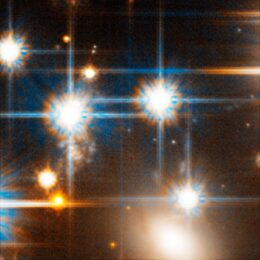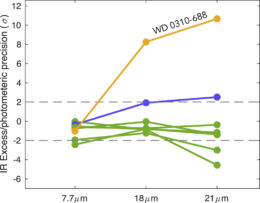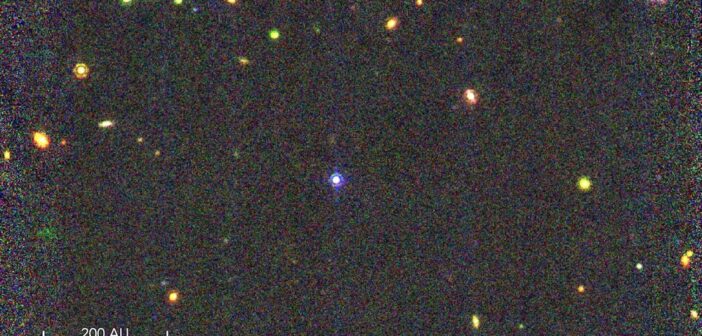What will happen to Earth and the other planets in our solar system when the Sun dies? Finding exoplanets around white dwarfs can help answer this pressing question, and researchers have discovered a possible giant exoplanet around a nearby white dwarf.
At the End of the Solar System

A white dwarf is faintly visible at the center of this Hubble Space Telescope image, tucked between the two brightest stars. [NASA, ESA and H. Richer (University of British Columbia); CC BY 4.0]
One way to probe the answer to this question is to study planetary systems orbiting white dwarfs. This may reveal the distances at which planets find safe harbor from the red giant, as well as whether any planets change or undergo migration as the result of their host star’s evolution. Historically, detecting planets around white dwarfs has been challenging — but luckily, JWST makes this task much easier.
Discovering Exoplanets with MEOW
The MIRI Exoplanets Orbiting White dwarfs (MEOW) survey is one of several surveys using JWST’s sensitive infrared instruments to search for planets around white dwarfs. In a recently published article, a team led by Mary Anne Limbach (University of Michigan) reported early results from the MEOW survey, focusing on a candidate planet around the nearby white dwarf WD 0310–688.

The measured infrared excess of WD 0310–688 (yellow line) compared to other white dwarfs in the MEOW sample (green and blue lines). [Limbach et al. 2024]
Candidate Considerations
Researchers have discovered a handful of exoplanets around white dwarfs already — what makes this discovery special? WD 0310–688 is only 34 light-years away, making it the closest white dwarf with a planet candidate, and no planet has ever been discovered 0.1–2 au from a white dwarf. Additionally, this marks the first planet around any type of star to be discovered with the infrared-excess method.

Schematic of the best-fitting disk from the team’s modeling. The disk must be very cold, highly inclined, and quite narrow to match the data. Coincidentally, the disk’s emitting area must be roughly the area of a giant planet. [Limbach et al. 2024]
Follow-up spectroscopy is needed to discern between the giant planet and cold disk hypotheses. Spectral features commonly found in the atmospheres of exoplanets would support the giant planet hypothesis, while a silicate feature would point toward the debris disk. Future work should illuminate the nature of this planet candidate as well as bring us new results from the MEOW survey!
Citation
“The MIRI Exoplanets Orbiting White dwarfs (MEOW) Survey: Mid-infrared Excess Reveals a Giant Planet Candidate around a Nearby White Dwarf,” Mary Anne Limbach et al 2024 ApJL 973 L11. doi:10.3847/2041-8213/ad74ed
